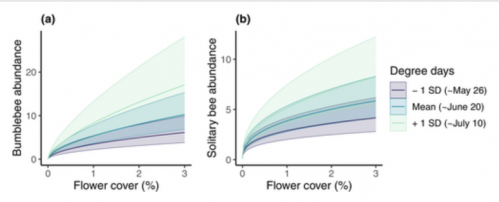Intensified agriculture has reduced wild bee populations by depleting floral resources. This decline, caused by habitat changes and altered farming practices, emphasises the need to enhance floral resources in agricultural areas. However, simplified landscapes not only reduce the amount of floral resources but also disrupt their timing, impacting bee populations. Recognising the role of seasonal floral availability in bee survival is key to targeted conservation efforts in agricultural landscapes. While there have been studies highlighting specific periods when floral resources may limit bee populations, understanding the dynamic relationships between floral resources and bees across years and within seasons remains limited.
A very recent paper published in the Journal of Applied Ecology, written by the SHOWCASE coordinating institution - Wageningen University and Research - explores how floral resources relate to bee abundance across the seasons, considering social and solitary bee behaviors across five years in the study area of south Limburg in the Netherlands as part of the experimental biodiversity area (EBA) network.
The findings revealed an unexpected trend of increasing populations for both bumblebees and solitary bees throughout the season, but a decreasing trend in floral availability. As the season progressed, the relationship between local flower cover and bee abundance became stronger, indicating greater resource limitation later in the season. In comparison, landscape flower cover did not predict solitary bee abundance and had somewhat of a lesser effect on bumblebees. These results indicate a temporal misalignment between the availability of floral resources and the abundance of bees, a phenomenon not previously established for the entire bee community. It is recommended to increase floral availability in summer by targeting large forms of land use such as pastures.
Read the full paper here.
Photo: Predictions and 95% confidence intervals for the effect of local flower cover on (a) bumblebee and (b) solitary bee abundance at low (−1 SD), mid (mean) and high (+1 SD) levels of degree days, back-transformed from the log scale. Source: Bishop, G., Fijen, T.P.M., Raemakers, I., Kats, R.J.M., Kleijn, D. Bees go up, flowers go down: Increased resource limitation from late spring to summer in agricultural landscapes. Journal of Applied Ecology (2024). https://doi.org/10.1111/1365-2664.14576
